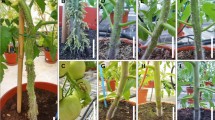Abstract
The cotton sesquiterpene cyclase, (+)-δ-cadinene synthase, is encoded by a gene family, which can be divided into two subfamilies:CAD1-A and CAD1-C. The geneCAD1-A was isolated fromG. arboreum. In situ hybridization performed on seven-day-old cotton seedlings localized transcripts of both the CAD1 -A and CAD1 -C mainly in lateral root primordium and apical ground meristem, vascular tissues of emerging lateral roots, and also in procambium and some subepidermal cells of the hypocotyl. The CAD1 -A promoter showed a similar tissue-specificity in transgenic tobacco plants. Histochemistry showed occurrence of sesquiterpene aldehydes in outer cells of the lateral root tips, as well as in pigment glands. The CAD1 gene expression in G.arboreum seedlings and the spatial pattern of sesquiterpene biosynthesis constitute a chemical defense machinery in cotton seedlings.
Similar content being viewed by others
References
Bell, A.A., Stipanovic, R. D., The chemical composition, biological activity, and genetics of pigment glands in cotton, in Proceedings of the Beltwide Cotton Production Research Conference, Atlanta, 1977, 244–258.
Chen, X. Y., Chen, Y., Heinstein, P. et al., Cloning, expression, and characterization of (+)-δ-cadinene synthase: a catalyst for cotton phytoalexin biosynthesis, Arch. Biochem. Biophys., 1995, 324: 255.
Alchannati, I., Patel, J. A. A., Liu, J. et al., The enzymatic cyclization of nerolidyl diphosphate by δ-cadinene synthase from cotton stele tissue infected withVerticillium dhaliae, Phytochemistry, 1998, 47: 961.
Davila-Huerta, G., Hamada, H., Davis, G. D. et al., Cadinane-type sesquiterpenes induced inGossypium cotyledons by bacterial inoculation, Phytochemistry, 1995, 39: 531.
Bohlmann, J., Meyer-Gauen, G., Croteau, R., Plant terpenoid synthases: molecular biology and phylogenetic analysis, Proc. Natl. Acad. Sci. USA, 1998, 95: 4126.
Chappell, J., Biochemistry and molecular biology of the isoprenoid biosynthetic pathway in plants, Annu. Rev. Plant Physiol. Plant Mol. Biol., 1995, 46: 521.
Starks, C. M., Back, K., Chappell, J. et al., Structural basis for cyclic terpene biosynthesis by tobacco 5-epi-aristolochene synthase, Science, 1997, 277: 1815.
Chen, X. Y., Wang, M. S., Chen, Y. et al., Cloning and heterologous expression of a second cotton (+)-δ-cadinene synthase, J. Nat. Prod., 1996, 59: 944.
Meng, Y. L., Jia, J.W., Liu, C. J. et al., Coordinated accumulation of (+)-δ-cadinene synthase mRNAs and gossypol in developing seeds ofGossypium hirsutum and a new member of the cad1 family fromG. arboreum, J. Nat. Prod., 1999, 62: 248.
Bell, A. A., Stipanovic, R. D., O’Brien, D. H. et al., Sesquiterpen aldehyde quinones and derivatives in pigment glands ofGossypium, Phytochemistry, 1978, 17: 1297.
Stanford, E. E., Viehoever, A., Chemistry and histology of the glands of the cotton plant, with notes on the occurrence of similar glands in related plants, J. Agr. Res., 1918, 13:419.
Alfandari, D., Darribere, T., A simple PCR method for screening cDNA libraries, PCR Method Appli., 1994, 4: 46.
Horsch, R. B., Fry, J. E., Hoffman, N. L. et al., A simple and general method for transferring genes into plants, Science, 1985, 227: 1229.
Jefferson, R. A., Assaying chimeric genes in plants: theGUS gene fusion system, Plant Mol. Biol. Rep., 1987, 5: 387.
Meyerowiz, E. M.,In situ hybridization in plant tissue, Plant Mol. Biol. Rep., 1987, 5: 242.
Rikhel, N. V., Bednarek, S. Y., Lerner, D. R.,In situ hybridization in plant tissues, Plant Molecular Biology Manual, 1989, B9: 1.
Meier, I., Hahlbrock, K., Somssich, I. M., Elicitor-inducible and constitutivein vivo DNA footprints indicate novel cis-acting elements in the promoter of a parsely gene encoding pathogenesis related protein 1, Plant Cell, 1991, 3: 309.
Rushton, P. J., Torres, J. V., Parniske, M. et al., Interaction of elicitor-induced DNA-binding proteins with elicitor response elements in the promoters of parsley PR1 genes, EMBO J., 1996, 15: 5690.
Mace, M. E., Bell, A. A., Stipanovic, R. D., Histochemistry and isolation of gossypol and related terpenoids in roots of cotton seedlings, Phytopathol., 1974, 64: 1297.
Harrison, M. J., Dixon, R. A., Spatial patterns of expression of flavonid/isoflavonoid pathway genes during interactions between rootsof Medicago truncatula and the mycorrhizal fungusGlomus versiforme, Plant J., 1994, 6: 9.
Facchini, P. J., Chappell, J., Gene family for an elicitor-induced sesquiterpene cyclase in tobacco, Proc. Natl. Acad. Sci. USA, 1992, 89: 11088.
Yin, S., Mei, L., Newman, J. et al., Regulation of sesquiterpene cyclase gene expression: characterization of an elicitor-and pathogen-inducible promoter, Plant Physiol., 1997, 115:437.
Author information
Authors and Affiliations
Corresponding author
Rights and permissions
About this article
Cite this article
Liang, W., Tan, X., Chen, X. et al. Isolation of a (+)- δ-cadinene synthase gene CAD1-A and analysis of its expression pattern in seedlings ofGossypium arboreum L.. Sci. China Ser. C.-Life Sci. 43, 245–253 (2000). https://doi.org/10.1007/BF02879283
Received:
Issue Date:
DOI: https://doi.org/10.1007/BF02879283




